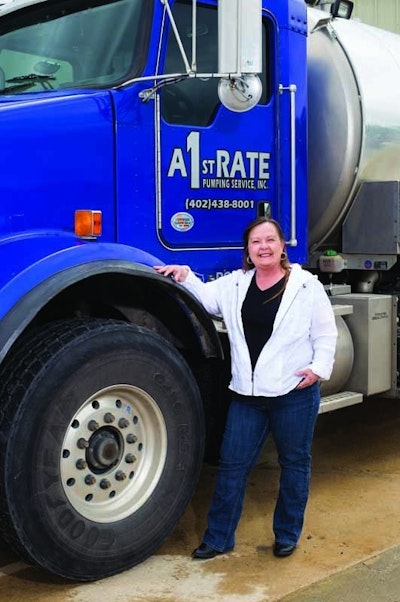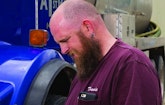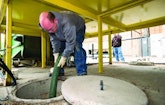
Interested in Pumps?
Get Pumps articles, news and videos right in your inbox! Sign up now.
Pumps + Get AlertsJulie Southwick never dreamed she’d be running A 1st Rate Pumping Service without her husband and business partner. But when Mark Southwick died suddenly in 2005 after 15 years in business, she found herself in exactly that position.
A background of sound business practices, established relationships, a rock-solid crew and sheer determination got her – and the company – through that tragedy. Here, she shares all the things she didn’t know, how she learned them, and how true grit brought her company to a thriving position a decade later.
DEEP ROOTS IN PUMPING
“Big Clyde” Southwick started a septic service business in the late 1960s in Raymond, Nebraska, just outside the state’s capital city, Lincoln. Six of his sons, including Mark, helped out. Mark learned pumping operations, customer service and how to build vacuum trucks, and became a proficient mechanic. Mark and Julie married in 1979 and had two children, son Jarred and daughter Katie.
After working occasional evenings and weekends for his dad, Mark became a full-time pumper in 1985. In 1990, one of his siblings bought their dad out when Clyde’s health declined. Mark and Julie decided they were ready to be their own bosses, so with Clyde’s blessing, they started A 1st Rate Pumping Service Inc.
The young Southwicks, Jarred and Katie, grew up working in the family business. Jarred was later encouraged to see what it was like working elsewhere, knowing he could always rejoin A 1st Rate. Katie works in all areas of the firm. She married Travis Taylor, who began working for the company. Though the couple is now separated, Taylor still works for the company.
Mark did the scheduling, ran the routes, maintained vehicles and equipment, and made major purchase decisions with Julie. She took care of administrative duties and handled phone calls. When Mark returned home in the evenings, he and Julie sat down to discuss their days. She would come to regret that they didn’t talk more in depth about the potential scenario in which one of them was left to run the business without the other.
The couple worked together to keep expenses down without cutting corners on service. Mark built all the company trucks, preferring German-manufactured Jurop/Chandler pumps. To save money on new pumps, they’d watch the stock market. When Deutsche marks were down against the U.S. dollar, they’d buy one.
DISASTER STRIKES
In 2005, the couple discussed building a new truck. By late June, Mark knew what kind of truck he wanted, including the size of tank and the pump system. “All we needed was to go talk with the banker about a loan,” Julie recalls. “We decided to wait until August so the truck would be ready for the fall during our busy time of the year.”
But it was not to be.
In early July, at a wedding reception, Mark suffered a heart attack and passed away shortly thereafter.
It was devastating losing her life partner, but Julie realized just how unprepared she was for also losing her business partner — and the head of the company.
“You’re scared to death, because now you’re facing the whole world by yourself,” she recalls. “You have to make funeral arrangements, you don’t know where everything is with information you need.” She recognized there were even more things she didn’t know about the business. “You don’t know where the company is with the progress of each job. I was clueless about what it took to bid jobs.”
She knew she’d have to learn that along with many other things, but first came the sting of reality from outside the shop walls. “Once Mark’s obituary hit the paper, competitors started calling up our customers,” she remembers.
Even through the veil of sorrow, Julie grasped that it was up to her to keep the company afloat. Her own livelihood and that of her children and Taylor depended on it. She allowed fear and insecurity to power her through the grief. She responded immediately by sending letters to clients, assuring them that despite the loss of her husband, A 1st Rate would be staying in business. Now she had to figure out how to keep that promise.
SEEKING SUPPORT
Julie had to dig deep to find the gumption to persevere.
“My pride was such a motivator. I wanted to keep what we had and I wanted Mark to be proud of me. I couldn’t really discuss things with the competition, and I didn’t know anybody else in the industry I could talk to about it. So I turned to a few friends who were in other types of business with their husbands.”
With the support of these friends and her family, Julie took it one day at a time, but kept moving forward. “I knew you weren’t supposed to make big decisions right after a traumatic event, but I had no choice,” she says. “I sat down with Jarred and Travis and asked them to give me one year. I said at that point, we’d re-evaluate and decide if we wanted to continue on.” The young men agreed to her proposition, and together the three developed a plan for the next 18 months.
Jarred had already given notice at his other job, and he jumped in with both feet, fully committed, making the rounds to see all of A 1st Rate’s clients in person. “I think that helped not just settle our clients’ nerves, it also helped Jarred’s confidence because he was now head of the household,” Julie says. “We’d always involved the kids in the company when we could, because we always presented ours as a family business. Now that was really paying off.”
BIG LEARNING CURVE
Julie took over administrative tasks previously handled by Mark, such as billing, computer data entry and monthly scheduling, which had been done in a ledger book. She moved to QuickBooks for the financials and now uses a full-function package through Smart Service (My Service Depot) that ports to QuickBooks.
“This allowed us to go paperless in the trucks in 2010,” she says. “Everything is tied into the field technicians’ iPads and iPhones. Now they just email back to the office anything that really needs to be printed, and we’ll send it where it needs to go. If they need to leave a service ticket, they’ll write one out by hand.”
When it came to getting familiar with service work, vehicles and equipment, Julie knew the challenge was immense. She found herself thinking back to the years she’d gone to the Pumper & Cleaner Expo (now the WWETT Show) with Mark, sitting in Education Day classes. She had learned how to inform customers about what was going to happen during service calls and what they needed to do, but the rest was a day-by-day learning experience.
Now she’s confident, only referring equipment and vehicle inquiries to Jarred and service questions to Taylor. “I handle the rest myself and still keep tight track of licensing, insurance, the paperwork and administrative stuff.”
Though she can’t forget the dark times her company went through a decade ago, Julie is mindful of and grateful for the way things turned out. Revenues have doubled since then. A 1st Rate has seen a 35 percent increase in new business, which she attributes to franchises adding restaurant locations.
BUILDING SUSTAINABILITY
Raising prices was also a key strategy in building revenues. “We have to look like a big corporation, though there are only four or five of us. The 2008 recession and the 2011 double-dip really hurt us. We increased rates then, and we had to tighten our budgets by dropping some noncritical advertising.”
She says she didn’t receive much pushback from customers when rates went up. “It’s mostly because of the service we offer. We specialize to each individual client. If that means we have to be there at 2 a.m. to avoid their busy periods, that’s what we do.”
Its single-niche market position allows A 1st Rate to realize annual growth of just 5 to 6 percent to remain profitable. This is sustainable because they don’t need to worry about staffing and training for many different services, or buying and maintaining all that equipment.
They refer collateral service inquiries to contractors perceived as above average, and the favor is reciprocated. “We have wonderful companies we refer to: plumbers, rootering, septic installation and repair, portables,” says Julie. The company also receives quite a few jobs through several maintenance service brokers via online portals.
Jarred now manages a healthy fleet that includes a truck like the one his dad was planning when he died. He’s proud of their 2015 Kenworth T-800 with a 4,000-gallon aluminum tank and National Vacuum Equipment 4307 blower, assembled by Imperial Industries. This is joined by a 2003 International 4300 with a 2009 Progress aluminum 2,000-gallon tank and Masport HXL 400 pump from Tri State Tank, and a 1992 Kenworth T-600 with a 1997 2,500-gallon steel tank and Masport HXL 400 pump from Mid-Continent Truck. A 1992 Chevy Silverado 1500 4x4 with liftgate and snowplow rounds out the fleet.
Julie finally felt financially secure enough to hire Colin Olson last year to help her with general administrative and IT duties. “I needed time to become the person who taught Jarred and Travis the ups and downs of the business. Mark taught Travis the fieldwork, but neither of them know the administrative aspect.” Taylor is now in charge of field operations.
SUCCESSION PLAN IS KEY
Julie came to the conclusion that her family tragedy didn’t have to become a business catastrophe as well. She wished she and Mark had spent more time talking in earnest about “what might happen.” It’s never a pleasant discussion to have, but it’s a necessary one for responsible business owners.
All parties invested in the business should sit down and make a five-year plan, she says, in case of the unexpected. “You don’t have to follow it, but at least it will give you guidance. I think Mark talked more to our technician about what to do than to me, which made sense because they were always together. But the business is legally a family operation, so anyone with a legal and financial stake in the company needs to be involved in planning for the future.”
Sadly, because not everyone participates in this kind of planning, mom-and-pop operations often leave this industry through the unexpected loss of an owner. “Most wives are not involved in the day-to-day operation (of their family businesses),” Julie says. “A lot of these women would probably just sell (if they ran into such a situation), which was an option that crossed my mind.”
A 1st Rate Pumping successfully emerged from the turmoil following Mark’s death. Julie credits the dedication of her team and their belief in each other and what they were trying to do. It’s a good bet that Mark would be proud of the team, too.









